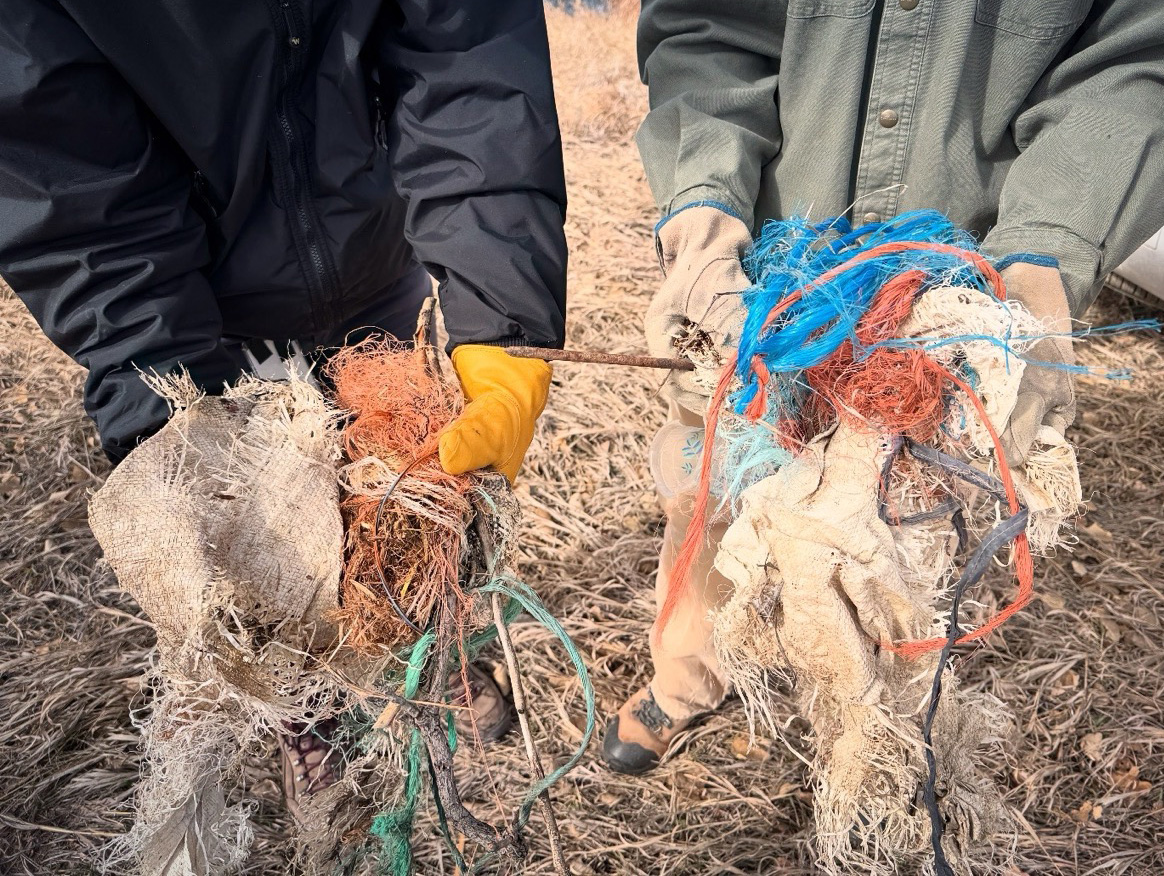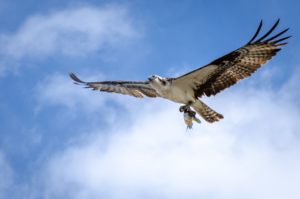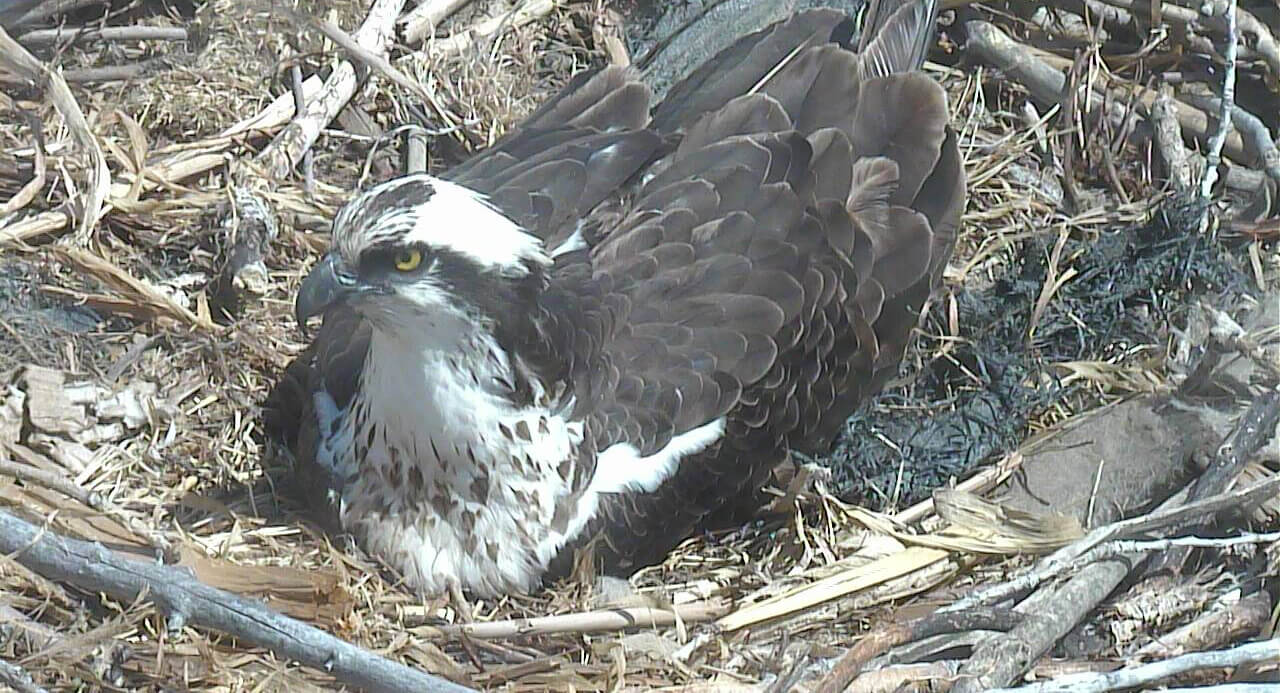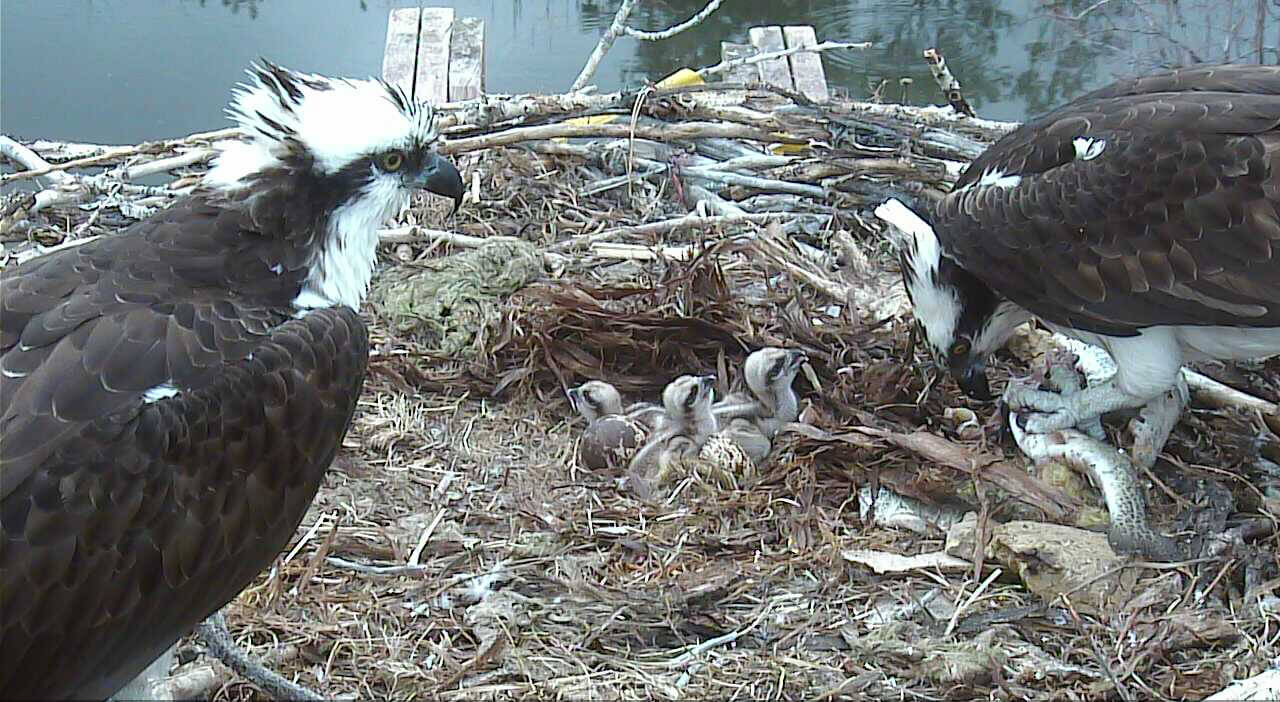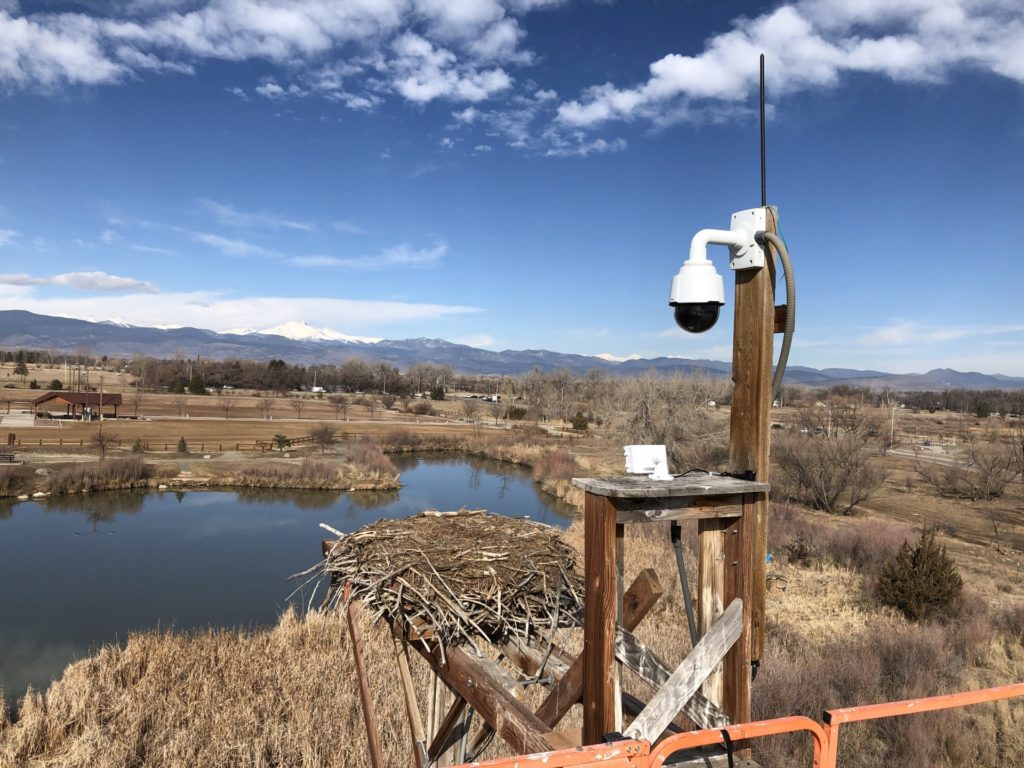Osprey Camera
Comments must follow the Comment Policy.
View Archived Comments | View Current Comments in New Window
Osprey Camera Comment Policy
- Comments reflect the views of the author and do not necessarily reflect the official views of Boulder County, its office holders, or employees.
- Comments should be directly related to the Boulder County Fairgrounds Osprey Camera and nest activities.
- Please keep your comments related to this osprey nest. We understand that people like to watch other cameras and chat about them, but this chat section is intended to focus on this specific osprey nest. If you wish to comment about another nest, please do so in an educational way. Moderators will help refocus comments when necessary.
- Boulder County does not name the birds. We refer to the birds as male, female, and chick #1, chick #2, etc. Please refrain from using formal names to refer to the birds.
- Please post your screenshots, photos, or recorded video you have taken. Any screenshots, photos, or videos that are not directly related to the osprey camera may be deleted.
- Copyrighted and other proprietary material should not be posted unless permission to do so is clearly indicated.
- Boulder County reserves the right to delete any comment at its discretion and will delete comments that:
- Contain obscene, indecent, or profane content.
- Contain threats or defamatory statements.
- Contain hate speech directed at race, color, sex, sexual orientation, national origin, ethnicity, age, religion, or disability.
- Promote or endorse services or products.
- Contain images, links, or other content not directly related to the osprey camera.
- Promote or endorse ballot issues, candidates for public office or other campaign-related material, or non-county related events and programs.
- Users who violate this policy may be banned from future commenting.
Timeline
Non-Intervention
Boulder County has a strict non-intervention policy with osprey and other raptors. Staff will not act to aid or assist raptors, including osprey on nesting platforms. Intervention causes extreme stress to raptors and could inadvertently cause harm or death. It is always best to minimize disturbance to wild animals as amplifying the challenges they already face in trying to survive is rarely beneficial. However, there are rare extenuating circumstances when intervention may make sense if, in the opinion of professional wildlife biologists, the risks associated with the intervention are deemed worth taking. These instances would need to have a clear and safe benefit to the raptor, coupled with no risk to the humans enacting the intervention. This camera is a look into nature and shows how harsh it can sometimes be.
Baling Twine
Ospreys are thriving in Boulder County, but they face dangers. Baling twine, or baler twine, is a rope-like material used to bind hay, straw, and other livestock feed. Ospreys collect it for their nests, but it can entangle them causing injury or death. Please secure and properly dispose of baling twine to protect ospreys.
- Secure and properly dispose of baling twine: If you use baling twine in your agricultural operations, make sure it is collected and stored in a secure location where ospreys cannot access it.
- Pick up stray twine when you see it: If you see twine while out and about, pick it up and dispose of it in the trash.
- Organize a cleanup: If you know someone who has more twine than they can handle, consider organizing a baling twine cleanup day with your friends or colleagues.
Fairgrounds Osprey
This is one of several osprey nests in Boulder County. In the spring of 2003, this osprey pair began nesting on a light pole at the Boulder County Fairgrounds and returned each year. In 2009, wildlife biologists moved the nest to its current location just east of the Cattail pond for the birds’ safety. The pair shifted to the new location with ease.
See the interactive timeline above for specific dates and other significant events.
Camera Setup
Camera #1 is an Axis P5635-E MkII network camera that can pan, tilt, and zoom. A microphone is positioned under the camera to record sound. They are powered directly from a building that is approximately 750 feet away but the video and audio feed are transmitted wirelessly. Camera #2 is an Axis P5655-E network camera that can also pan, tilt, and zoom. It is located approximately 100 feet from the nest on the ground looking up to the nest. It uses the same audio source as Camera #1.
The nest is illuminated at night using an infrared light. The infrared light is powered using a battery that charges during the day with a solar panel. Infrared light is undetectable by ospreys so it does not disturb them.
A lightning rod, two lightning suppression units, and shielded cables are used to protect the setup from lightning strikes.
Donations
Ongoing maintenance and streaming costs are provided by the Boulder County Parks & Open Space Foundation. If you enjoy watching the ospreys, please consider a donation to the Parks & Open Space Foundation.
About Osprey
Migration
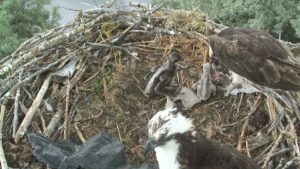 Ospreys migrate south every year to Central or South America. The male, female, and offspring all go their separate ways. The male and female migrate and winter separately but return to the same nesting site each year. Offspring usually remain at their wintering grounds for their entire first year before beginning a migration and nesting pattern.
Ospreys migrate south every year to Central or South America. The male, female, and offspring all go their separate ways. The male and female migrate and winter separately but return to the same nesting site each year. Offspring usually remain at their wintering grounds for their entire first year before beginning a migration and nesting pattern.
Ospreys return to their nesting site mid to late March and complete mating and egg-laying within the first two weeks after both have arrived. They leave in September after the chicks have fledged.
Other birds use the platform whether the osprey are present or not. Magpies and blackbirds have been spotted on the platform even when the osprey were on the nest. Geese, red-tailed hawks, bald eagles, great horned owls, and great blue herons have also been seen on the nest.
Diet
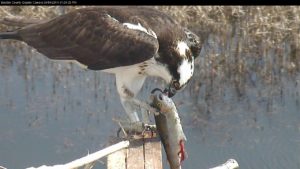 The osprey is the only local raptor that almost exclusively hunts fish. On rare occasions, they will eat squirrel or muskrat. Osprey will sometimes scout for fish from its nest. Once a fish is spotted, the osprey will drop down in the water fully submerged. Their dense and oily feathers allow them to come back out of the water and fly away. They are successful just over half the time on that first dive. Some of the public places you can see them fishing are: Fairgrounds lake, Twin Peaks golf course, Lagerman Reservoir, Izaak Walton Pond, Golden Ponds, and Pella Crossing.
The osprey is the only local raptor that almost exclusively hunts fish. On rare occasions, they will eat squirrel or muskrat. Osprey will sometimes scout for fish from its nest. Once a fish is spotted, the osprey will drop down in the water fully submerged. Their dense and oily feathers allow them to come back out of the water and fly away. They are successful just over half the time on that first dive. Some of the public places you can see them fishing are: Fairgrounds lake, Twin Peaks golf course, Lagerman Reservoir, Izaak Walton Pond, Golden Ponds, and Pella Crossing.
The Nest
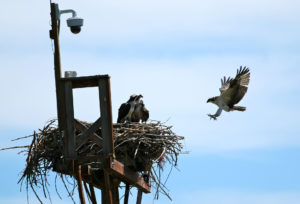 The nest is mainly used for the osprey’s offspring. The nests have to be wide enough to support up to six full-sized birds. Osprey nests weight an average of 400 pounds and are amended yearly. No one knows why they collect all the different things that they do for their nest (including trash), other than to make the lining soft and to keep eggs from falling into voids in the stick nest. Osprey chicks only have a 50% chance of surviving their first year.
The nest is mainly used for the osprey’s offspring. The nests have to be wide enough to support up to six full-sized birds. Osprey nests weight an average of 400 pounds and are amended yearly. No one knows why they collect all the different things that they do for their nest (including trash), other than to make the lining soft and to keep eggs from falling into voids in the stick nest. Osprey chicks only have a 50% chance of surviving their first year.
Ospreys occasionally build nests on power poles, putting them at risk of electrocution. When this occurs, Boulder County collaborates with Colorado Parks and Wildlife and local utility companies to construct nearby nesting platforms, providing a safer alternative for the birds.
Learn More
Learn more about osprey at the Cornell Lab of Ornithology.
Problems Loading the Video
The live video feed is provided by YouTube. If your network blocks access to YouTube, then you may not be able to watch the live feed. Try playing the video directly from YouTube.
Because this is a live streaming video, YouTube blocks it to users who have enabled Restricted Mode. To turn it off, scroll to the bottom of any YouTube page and click the Restricted Mode button. Learn more about Restricted Mode.


